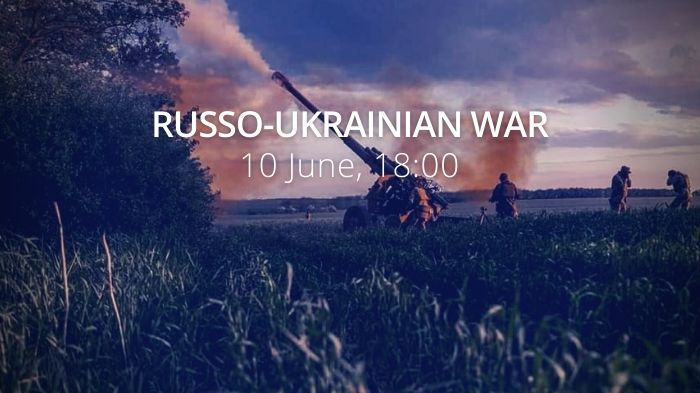Morning report day 108 – June 11: Situation
An overview of the latest military events as per military expert Roman Ponomarenko:
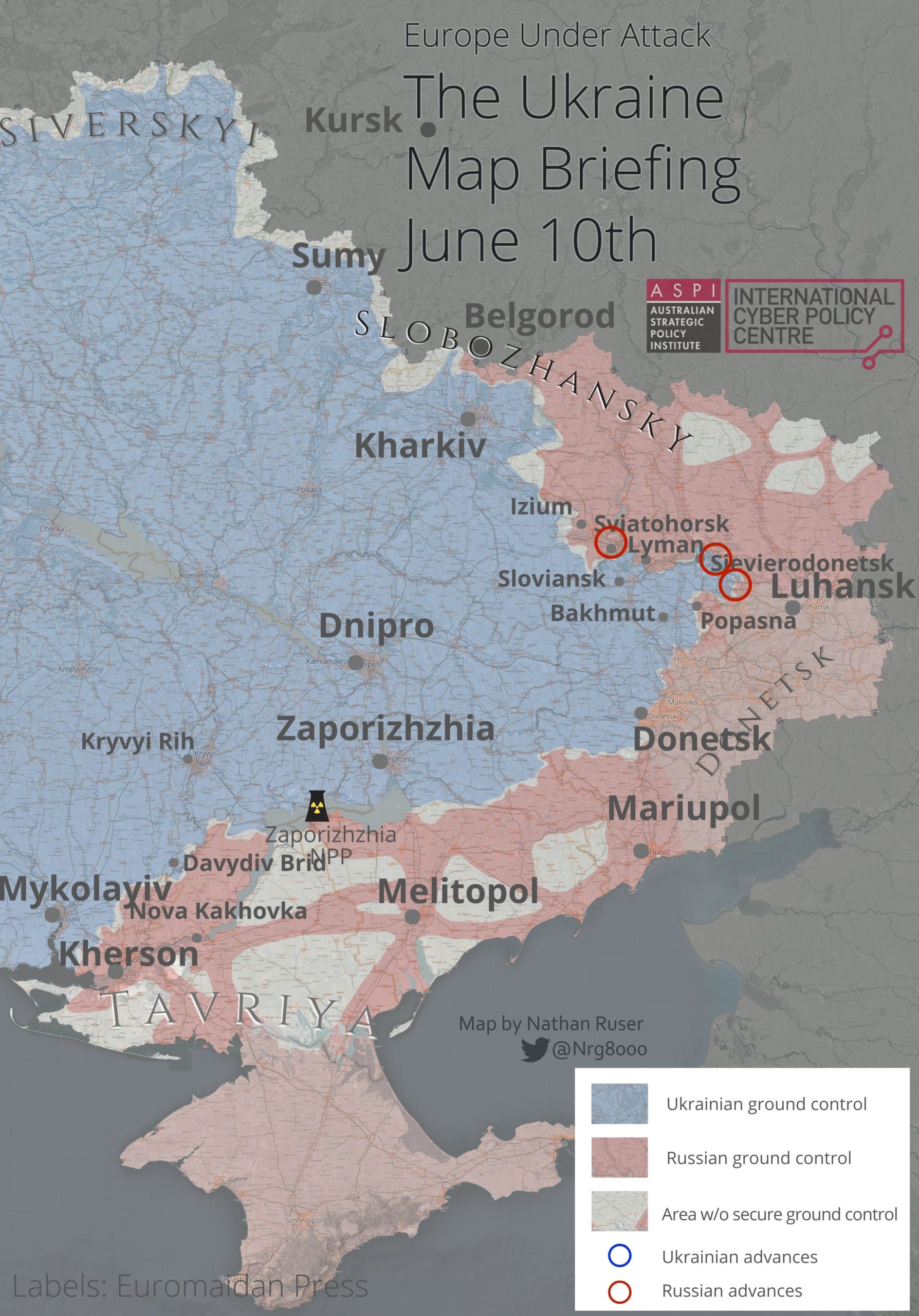
Kharkiv Oblast: Russia inflicted a number of attacks on Ukrainian troops and reported on the capture of two villages near the border - Ternova and Varvarivka. Fights for these villages have been going on for several weeks, they were passed back and forth several times. Therefore, even if the Russians achieved some local success there, nothing terrible happened, the usual "swing" for this part of the front. It would not be surprising if Ukraine recaptured these villages in a couple of days.
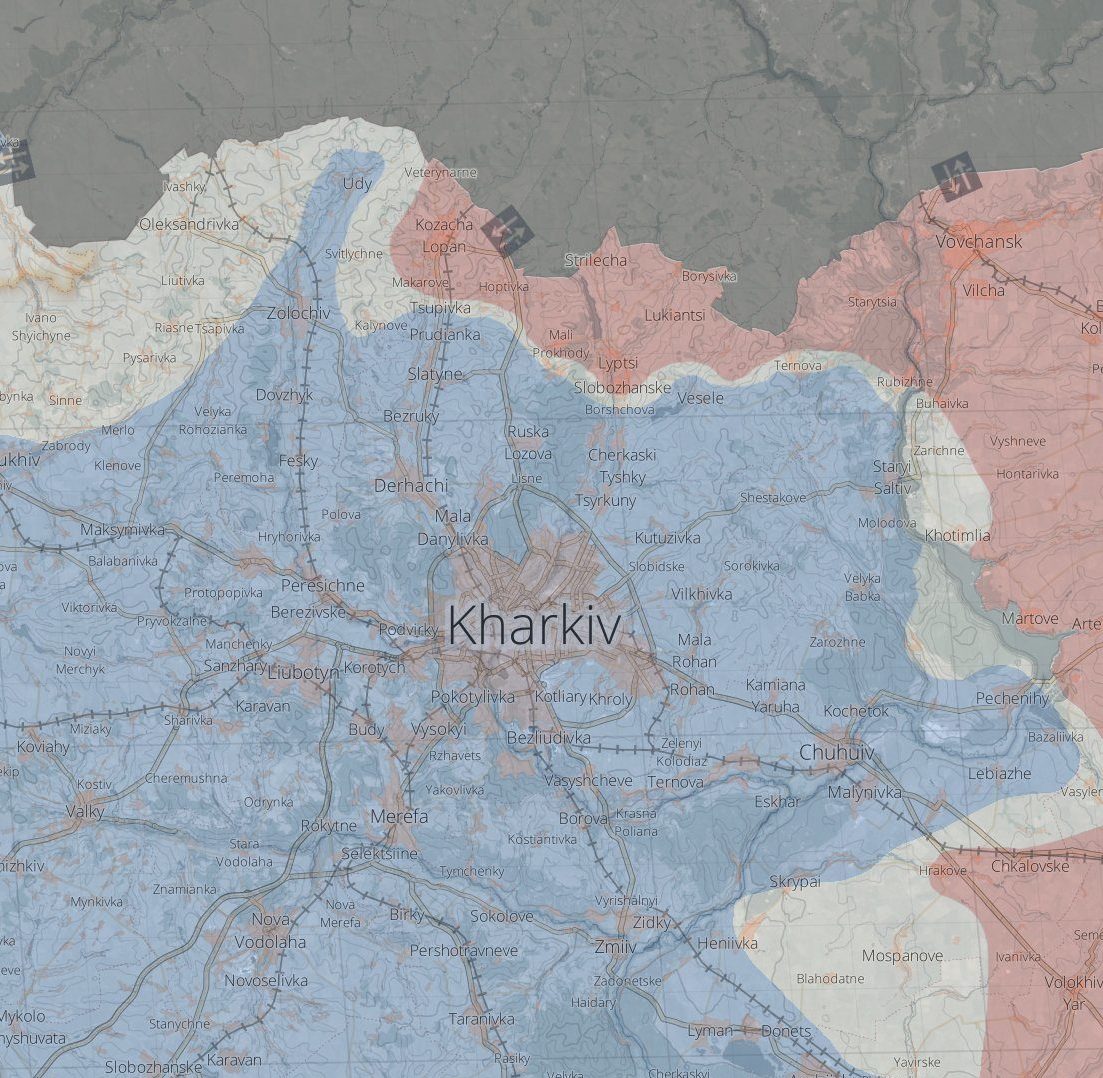
Sloviansk: according to Russian statements, 70,000 Ukrainian servicemen are in the Sloviansk-Kramatorsk area. It is unclear what the actual number is, but let Russians keep thinking that, as until they amass enough resources to launch a massive assault on Sloviansk, fighting of varying intensity continues on the same approaches to the city as a few days ago. In particular, in the area of Bohorodychne, Sviatohorsk, and Raihorodok.
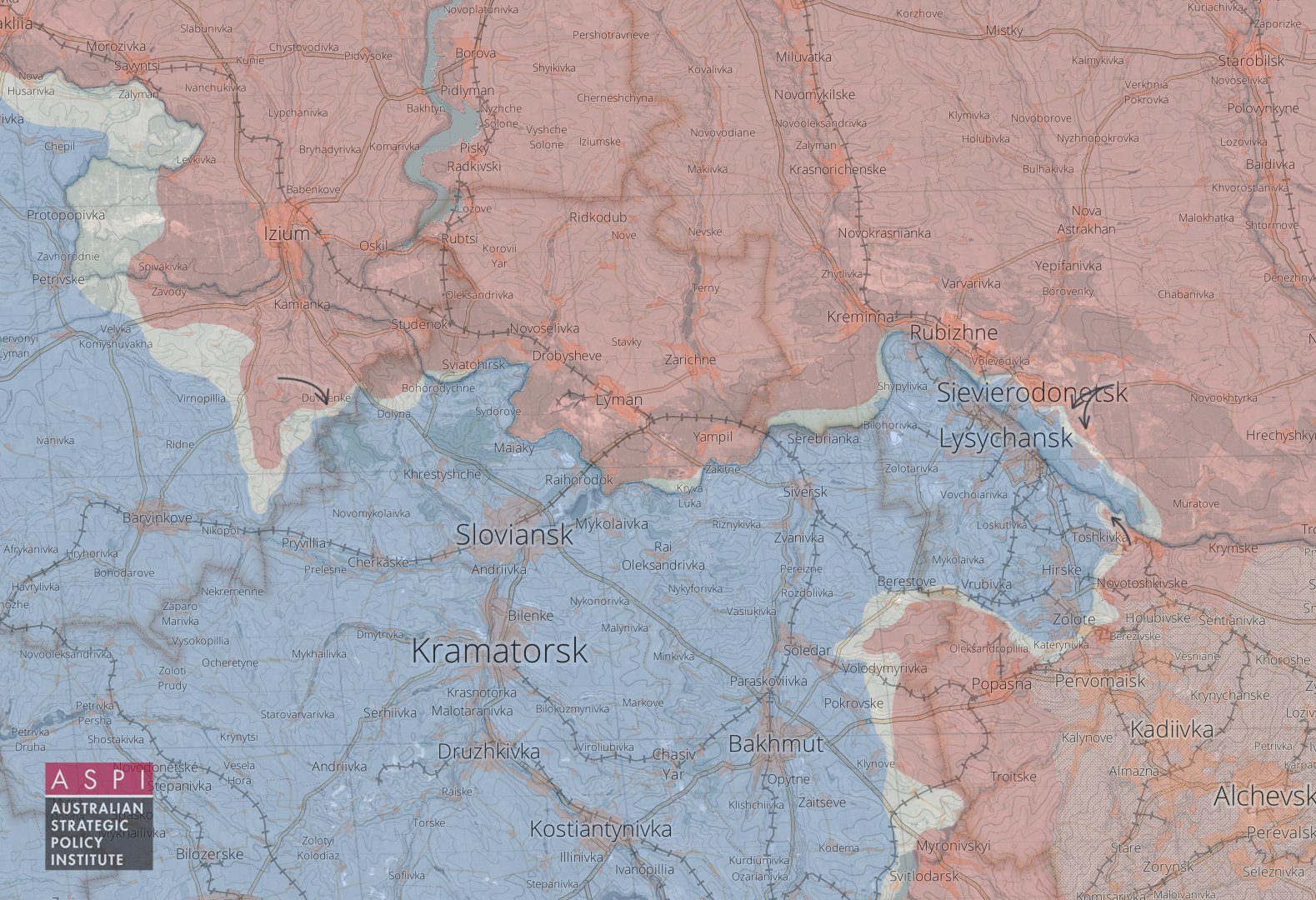
Luhansk Oblast: the situation is unchanged compared to yesterday. The Ukrainian Army holds the Sievierodonetsk industrial zone (approximately half of the city), the approaches to Lysychansk, Bakhmut, Soledar, and the road to Lysychansk. Despite the considerable forces involved, Russian troops are currently unable to advance greatly.
Donetsk Oblast: Russian troops attacked north of Svitlodarsk, in the direction of Vozdvyzhenka-Rota, had "partial success," according to our General Staff. Nothing special happened in other sectors: air strikes, and artillery shelling.
Kherson Oblast: there is no data on a Ukrainian advance, but Ukrainian aircraft did conduct bombings and assaults on enemy clusters in five different parts of the oblast.
Zaporizhzhia and Mykolaiv oblasts: there were no special battles, all as usual, artillery shelling and air raids.
Interestingly, the Russians said that on June 4 they sank the Ukrainian corvette "Vinnytsia." However, the Ukrainian Navy wrote off this ship in January 2021, and it stood at the berth, waiting to be turned into a floating museum. But it will now be a museum of Russian stupidity.
Information from the General Staff as of 06.00 11.06.2022, supplemented by its [18:00 assessment], is in the drop-down menu.
- Extended terms:
- until June 18 of the current year, an inspection of the combat readiness of the armed forces of the Republic of Belarus;
- until July 8 of this year, the closure of airspace over the southern part of Belarus.
- The threat of missiles and airstrikes from the territory of Belarus remains.
In the Siversky direction, Russian forces continue to hold up to three battalion tactical groups from the Western Military District on the Russian-Ukrainian border in the Bryansk and Kursk regions to prevent the transfer of our troops to other threatening areas. The aggressor fired artillery at the positions of our troops in the border areas of the Sumy region.
[In the Slobozhansky direction:]
- In the Kharkiv direction, Russian forces focused on defending and preventing the further advance of our troops to the State Border. [Yesterday, they fired mortars, artillery and rocket-propelled grenade launchers at our units in the areas of Kharkiv, Krynychna, Husarivka, Bayrak and Chepil.]
- In the Sloviansk direction, Russian forces focus on preparing troops for the attack on Sloviansk. Conducts assault operations in the direction of Pasika - Bohorodychne. It is successful, trying to gain a foothold on the northwestern outskirts of the Virgin. [Yesterday, Russian forces fired artillery at the settlements of Dolyna, Chervona Polyana, Nova Dmytrivka, Hrushuvakha and Dibrivne.]
[In the Donetsk direction:]
- In the Lyman direction, Russian forces regrouped troops and replenished ammunition and fuel supplies in preparation for the offensive on Sloviansk and Siversk. [Yesterday, Russian forces did not wage active hostilities in the Lyman direction. Continues to consolidate in the area of Svyatohirsk. Takes measures to continue the offensive in the direction of the Lyman - Sloviansk. He fired near Dronivka and Serebryanka.]
- In the Siveerodonetsk direction, Russian forces are advancing in the direction of Novotoshkivske - Orikhove. Has partial success, and is fixed on the northern outskirts of the village of Orikhove. Continues to carry out assault operations in the city of Sievierodonetsk. [Yesteday, Russian forces fired artillery at the settlements of Sievierodonetsk, Lysychansk, Ustynivka, Toshkivka, Zolote and Hirske.]
- In the Bakhmut direction, the occupiers are regrouping in order to attack Mykolayivka and Komyshuvakha. To strengthen the grouping of troops moved to one battalion tactical group. [Yesterday, enemy fire activity was recorded near New York, Zolote, Vrubivka, Komyshuvakha, Berestov and Luhanske.]
- In the Avdiivka, Kurakhiv, Novopavliv and Zaporizhzhia directions, Russian forces are actively using aircraft and artillery to bind our troops and prevent the transfer of reserves to other directions. [Yesteday, they fired mortars, artillery and MLRS in the areas of Avdiivka, Tonenke, Nevelske, Marinka, Orikhiv, Opytne and Novobakhmutivka.]
- [Yesterday Russian forces launched airstrikes using Su-25 aircraft near Marinka and Krasnohorivka and Ka-52 helicopters near Novobakhmutivka and Mi-8 near Oleksandropil. In the Novopavlovsk direction, Russian forces strengthened the grouping of its troops.]
In the Pivdennyy Buh direction, Russian forces are conducting defensive operations. Russian forces are taking measures to improve the fortification equipment of the second and third lines of defence. Fortified checkpoints made of reinforced concrete structures located near the bridges across the North Crimean Canal were marked.
- [The situation in the Bessarabian direction has not changed significantly.]
[In the waters of the Black Sea and the Sea of Azov, Russian forces are focusing their efforts on blocking civilian shipping. “The naval group of Russia’s Black Sea Fleet, reinforced with another submarine carrying cruise missiles, continues to blockade the northwestern part of the Black Sea. The threat of 40 cruise missile strikes from the sea is remaining high. In addition, a large landing craft is staying at the sea, according to Operational Command South”]
Over the past 24 hours, the defenders of Ukraine in the Donetsk and Luhansk areas repulsed fourteen enemy attacks and destroyed four tanks, two artillery systems, eleven armoured combat vehicles, three units of vehicles and a warehouse with enemy ammunition. Air defence units shot down four Orlan-10 unmanned aerial vehicles.
[It is increasingly difficult for Russian forces to replenish units that have suffered losses as a result of the war on the territory of Ukraine. The aggressors are trying to solve the problem of recruitment by promising favourable financial conditions and the introduction of short-term contracts for military service. The occupiers themselves call such contracts "one way".]”
Intense fighting in Ukraine's bombed-out Sievierodonetsk, Reuters reports. “Ukrainian forces were holding their positions in intense street fighting and under day and night shelling in Sievierodonetsk, officials said, as Russia pushes to control the bombed-out city, key to its objective of controlling eastern Ukraine.
In a rare update from Sievierodonetsk, the commander of Ukraine's Svoboda National Guard Battalion, Petro Kusyk, said Ukrainians were drawing the Russians into street fighting to neutralise their artillery advantage. "Yesterday was successful for us - we launched a counteroffensive and in some areas, we managed to push them back one or two blocks. In others, they pushed us back, but just by a building or two," he said in a televised interview. But he said his forces were suffering from a "catastrophic" lack of counter-battery artillery to fire back at Russia's guns, and getting such weapons would transform the battlefield”.
Russians withdraw Buryat troops from Sievierodonetsk because they’re “dropping like flies” – Haidai, Ukrainska Pravda reported on Thursday. Serhii Haidai, the head of the Luhansk Oblast Military Administration, has reported that the Russians have withdrawn the remaining Buryat troops from Sievierodonetsk because they are significantly weaker than the Ukrainian troops.
Russia starts using more bombs and powerful missiles to strike Kharkiv, Ukrinform reports. "Although the intensity of shelling of Kharkiv has decreased, bombs and more powerful missiles are launched on the city. And the destructions are very, very serious. The situation, of course, is tense, but under control, Kharkiv Mayor Ihor Terekhov said. Russian forces want to destabilize the situation in the city to prevent businesses from working and make people feel constant fear, he noted. According to him, about 150,000 Kharkiv residents have been left homeless.”
According to British Defence Intelligence, (last 48 hours):
- As of 10 June, Russian forces around Sievierodonetsk have not made advances into the south of the city. Intense street-to-street fighting is ongoing and both sides are likely suffering high numbers of casualties. Russia is massing fires with its artillery and air capabilities, in an attempt to overwhelm Ukrainian defences.
- Since April, Russian medium bombers have likely launched dozens of 1960s era Kh-22 (NATO designation, AS-4 KITCHEN) air-launched, heavy anti-ship missiles against land targets. These 5.5 tonne missiles were primarily designed to destroy aircraft carriers using a nuclear warhead. When employed in a ground attack role with a conventional warhead they are highly inaccurate and can therefore cause significant collateral damage and civilian casualties.
- Russia is likely resorting to such inefficient weapon systems because it is running short of more precise modern missiles, while Ukrainian air defences still deter its tactical aircraft from conducting strikes across much of the country.
- Fighting continues around Sievierodonetsk. Russia is again in control of most of the city, but its forces have made little progress in attempts to encircle the wider area from the north and south.
- Russia is struggling to provide basic public services to the population in Russian-occupied territories. Access to safe drinking water has been inconsistent, while major disruption to telephone and internet services continues. There is likely a critical shortage of medicines in Kherson, while Mariupol is at risk of a major cholera outbreak. Isolated cases of cholera have been reported since May.
- Ukraine suffered a major cholera epidemic in 1995, and has experienced minor outbreaks since, especially around the Azov Sea coast - which includes Mariupol. Medical services in Mariupol are likely already near collapse: a major cholera outbreak in Mariupol will exacerbate this further.
A French journalist from France TV Moscou managed to film a cemetery in Mariupol where are more than 3000 new graves. This is still only one of those journalists who were allowed to Mariupol by Russian occupiers.pic.twitter.com/t9Bj32CDn3
— Euromaidan Press (@EuromaidanPress) June 10, 2022
As of Saturday 11 June, the approximate losses of weapons and military equipment of the Russian Armed Forces from the beginning of the war to the present day:
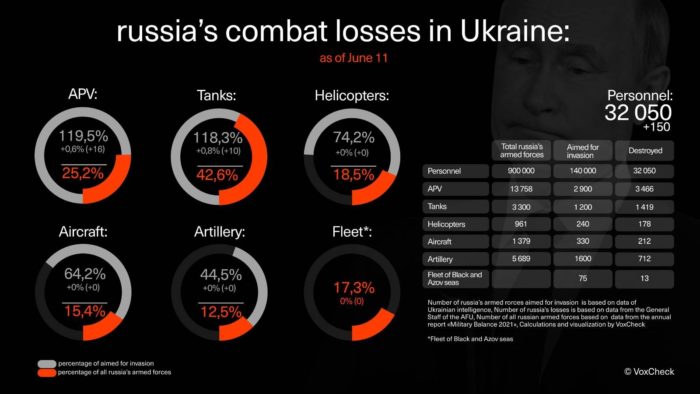
- Personnel – more than 32050 (+150),
- Tanks – 1419 (+10),
- Armoured combat vehicles – 3466 (+16),
- Artillery systems – 712 (+0),
- Multiple rocket launchers –MLRS - 222 (+0),
- Air defence means – 97 (+0),
- Aircraft - 212 (+0),
- Helicopters - 178 (+0),
- Automotive technology and fuel tanks – 2448 (+10),
- Vessels/boats - 13 (+0),
- UAV operational and tactical level – 579 (+7),
- Special equipment – 54 (+1),
- Mobile SRBM system – 4 (+0),
- Cruise missiles – 125 (+0)
Russian enemy suffered the greatest losses (of the last day) in the Sievierodonetsk and Bakhmut directions.
Ukrainian military casualties are now between 100 and 200 per day, Mykhailo Podoliak, a senior adviser to President Volodymyr Zelensky of Ukraine, said in an interview with the BBC on Thursday. Zelensky said last week that the Ukrainian army was losing 60 to 100 soldiers a day.
Russia claims it is currently holding 6,489 Ukrainian prisoners of war, The New York Times reports, citing Sergei K. Shoigu, the Russian Minister of Defence.
Humanitarian
Cholera and other diseases could kill thousands in Ukraine's Mariupol – mayor, Reuters reports. “Cholera and other deadly diseases could kill thousands of people in the southern Ukrainian city of Mariupol as corpses lie uncollected and summer brings warmer weather, its mayor said on Friday. Mayor Vadym Boichenko said wells had been contaminated by the corpses of people killed during weeks of Russian bombardment and siege, and that the collection of bodies by the city's Russian occupiers was proceeding slowly.
"There is an outbreak of dysentery and cholera. This is, unfortunately, the assessment of our doctors: that the war which took over 20,000 residents ... unfortunately, with these infection outbreaks, will claim thousands more Mariupolites," he told national television
.”
The occupiers are bringing their families to Kherson Oblast, Ukrainska Pravda reports. "In Kherson and some cities in the region, information has been coming out that the military occupiers are bringing their families over in an attempt to convince the locals that they will be there forever,” Operational Command South claims.
[Hans Petter Midttun: This must be seen in the context of the refugee situation created by the war, the filtration camps, and the forced relocation of Ukrainians. Russia is changing the demography in the region to make future reintegration “impossible”]
Millions of refugees from Ukraine have crossed borders into neighbouring countries, and many more have been forced to move inside the country. The escalation of conflict in Ukraine has caused civilian casualties and destruction of civilian infrastructure, forcing people to flee their homes seeking safety, protection and assistance the UNHCR reports. They need protection and support. As of 9 June:
Individual refugees from Ukraine recorded across Europe: 4,904,207
- Belarus, Hungary, Republic of Moldova, Poland, Romania, Russian Federation, Slovakia 2,574,093
- Other European countries 2,330,114
Refugees from Ukraine registered for Temporary Protection or similar national protection schemes in Europe: 3,206,642
- Hungary, Poland, Romania, Slovakia 1,290,949
- Other European countries 1,915,693
Border crossings from Ukraine (since 24 February 2022): 7,363,623
Border crossings to Ukraine (since 28 February 2022): 2,387,834
OHCHR recorded 9,585 civilian casualties in Ukraine as of June 9. 4,339 were killed (including 274 children) and 5,246 injured (including 443 children).
Environmental
Direct damage caused to Ukraine’s infrastructure during the war is $103.9 billion, Russia Will Pay, a project run by the KSE Institute [Kyiv School of Economics] with the support of the government and the Office of the President of Ukraine, reports. As of June 8, the total adjusted amount of direct damage to Ukraine’s economy from damage and destruction of residential and non-residential buildings and infrastructure is $103.9 bln, or UAH 3 trillion.
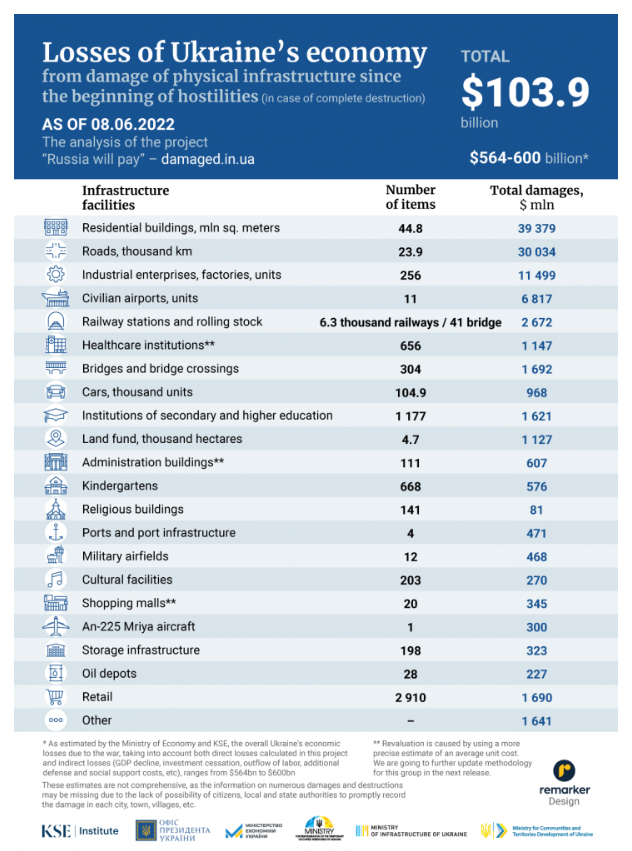
Some reduction in the total amount of direct infrastructure damage (by $2.6 billion) is due to the recalculation of losses caused to certain categories of the railway infrastructure, private cars, religious and cultural buildings. At the same time, the “organic” increase in the value of damaged/destroyed property as a result of hostilities over the past week is $1 billion.
In the last week, the damage to enterprises, educational and healthcare institutions, kindergartens, administrative buildings, and warehousing infrastructure has increased. Damage caused to the destruction and damage to Ukrainian enterprises has already reached $11.5 bln, educational institutions - $1.6 bln, medical institutions - $1.1 bln, and kindergartens - $576 mln.
Since the beginning of Russia’s war against Ukraine, at least 44.8 million square meters of housing, 256 enterprises, 656 medical institutions, 1,177 educational institutions, 668 kindergartens, 198 warehouses, 20 shopping centres and 28 oil depots have been damaged, destroyed or seized.
According to updated estimates, as a result of the war, Ukrainians lost almost 105,000 private cars, the total amount of such damage is $968 mln. These calculations do not take into account the number and value of cars not registered in Ukraine, so the actual amount of such damage may be higher.
According to the latest data, at least 141 religious and 203 cultural buildings have already been destroyed or damaged by the hostilities, direct damage caused to churches, laurels, and cathedrals is $81mln, as well as damage to cultural property, is $272 mln. The largest number of damaged religious, cultural, and sports facilities is in Kharkiv, Kyiv, and Donetsk regions.
As estimated by the Ministry of Economy and KSE, the overall Ukraine’s economic losses due to the war, taking into account both direct losses calculated in this project and indirect losses (GDP decline, investment cessation, the outflow of labour, additional defence and social support costs, etc), range from $564 billion to $600 billion.
Mine cleared in over 370 settlements liberated from Russian troops – Tymoshenko, Ukrinform reports. "Currently, more than 1,000 towns and villages in Ukraine have been de-occupied. Mines were cleared in four settlements last week. In total, more than 370 settlements have been cleared of explosive devices," [Kyrylo Tymoshenko, deputy head of the President's Office,] said. In addition, Tymoshenko said that health care facilities have resumed operations in 445 liberated settlements and education institutions in more than 450.”
Legal
- Terrorists "sentence" to death 3 foreigners who defended Ukraine, Ukrainska Pravda reports, citing the Russian “news outlet” RIA Novosti. “The so-called "Supreme Court of the DNR" [self-proclaimed Donetsk People’s Republic] has served the first sentence to foreign fighters who fought on the side of Ukraine." These are the British Aiden Eislin and Sean Pinner, and the Moroccan Saadun Brahim. They have been sentenced to death. The occupiers have given the foreign defenders of Ukraine a month to appeal against the "decision" of the so-called court.”
- The death sentence of two Britons ‘egregious breach’ of Geneva convention, the U.K. says, The Washington Post reports. “British officials said Friday that two British fighters who were sentenced to death for fighting in Ukraine against Russia should have protections under the Geneva convention, while a spokesman for the British prime minister described their release as a priority. […] The United Nations Human Rights Office also said Friday it was concerned about the death sentences, which were handed down by a court that is not internationally recognized.”
Russia Opens 1,100 Cases Against Ukrainian P.O.W.s, Raising Fears of Show Trials, The New York Times reports. “Russian investigators on Thursday said they had opened more than 1,100 cases into “crimes against peace” committed by the Ukrainian government, paving the way for what could turn into a mass show trial of hundreds of Ukrainian service members.
From the start, Russia has justified its invasion of Ukraine with a false claim that the government in Kyiv is controlled by far-right, pro-Nazi groups that have perpetrated “humiliation and genocide” against the Ukrainian people. Announcing the invasion in February, President Vladimir V. Putin claimed the purpose of the offensive was to “demilitarize and denazify Ukraine, as well as bring to trial those who perpetrated numerous bloody crimes against civilians.”
Russian investigators are now moving forward with cases against Ukrainian soldiers, fulfilling Mr. Putin’s promise. […] Beyond holding trials to support its narrative of the war, the Kremlin might also turn the fate of these prisoners into a powerful bargaining chip in any future talks with Kyiv.
The Investigative Committee, the country’s top investigative body, said in a statement that hundreds of Ukrainian service members, including more than 200 officers, had already been interrogated. Among them were those captured at the sprawling Azovstal steel plant in the southern Ukrainian city of Mariupol.”
The Kremlin wants to unite the occupied territories into a separate federal district of the Russian Federation – Russian media, Ukrainska Pravda reports, citing Meduza. “Russia is preparing to unite the occupied territories of Kherson and Zaporizhzhia oblasts, as well as the separatist so-called "DNR" [Donetsk People’s Republic ] and "LNR" [Luhansk People’s Republic ] into a separate federal district of the Russian Federation. According to the publication, the Kremlin is currently discussing two dates for pseudo-"referendums". The first will be held "in mid-July if the situation at the front allows". And the second, "more realistic" one on 11 September, the unified day of voting in Russia (the same day the gubernatorial elections will take place).”
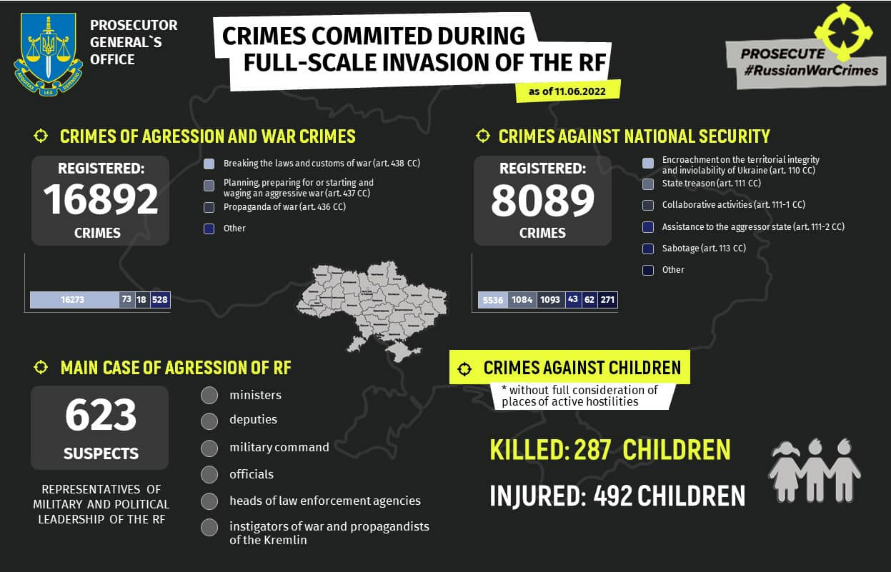 US diplomat: Russia has begun the formal process of annexing the Kherson region, Ukrainska Pravda reports, citing Suspilne. "Kherson in particular has become part of what I've called the Kremlin's laboratory of horrors. This is where we're seeing the Kremlin executing on their playbook of trying to absorb Ukraine into Russia. And we've seen elements of this playbook before. So some of this is sadly quite familiar. We still believe that the Kremlin is waiting for an opportunity to try to annex the Kherson region to Russia. We believe a sham referendum is one possibility."
US diplomat: Russia has begun the formal process of annexing the Kherson region, Ukrainska Pravda reports, citing Suspilne. "Kherson in particular has become part of what I've called the Kremlin's laboratory of horrors. This is where we're seeing the Kremlin executing on their playbook of trying to absorb Ukraine into Russia. And we've seen elements of this playbook before. So some of this is sadly quite familiar. We still believe that the Kremlin is waiting for an opportunity to try to annex the Kherson region to Russia. We believe a sham referendum is one possibility."
287 children were killed, and 492 children injured
, the Office of the Prosecutor General of Ukraine reports as of June 9. 1971 educational establishments are damaged as a result of shelling and bombings, 194 of them are destroyed fully. 16,431 crimes of aggression and war crimes and 7,815 crimes against national security were registered.
Support
The Minister of Defence published a strong, balanced, and honest report on defence support received and support needed on Thursday. The statement itself is a testimony to some of the many changes we have witnessed in Ukraine. The following is an extract of his statement:
I am happy to inform you that Polish self-propelled artillery units AHS Krab is ready to carry out combat missions at the front. After M777 and FH70 howitzers, CAESAR self-propelled howitzers and M109A3, these units are the 5th type of 155 mm artillery that we managed to obtain. […]
https://twitter.com/EuromaidanPress/status/1534890558073626624
After 24 February, providing the army with weapons, ammo, military and special equipment has become the top priority. We had to learn very quickly because the Ministry of Defence was not adapted to large-scale weapon imports and had no respective competencies. Moreover, the state in general had no such competencies to a sufficient extent because emphasis had been previously made on the export of domestic weaponry. […] A key strategic decision of the past period was a change in philosophy: we launched the transfer of the Armed Forces of Ukraine to heavy weaponry used by NATO member states. First of all, this applies to artillery, which plays a decisive role.
In early March we were already well aware that during an intensive war with Russia our resources were depleting, and our existing reserves were incomparable to those of Russian forces. Relying solely on Soviet weapons was definitely a losing strategy. Therefore, by turning to our partners for help, we initiated the supply of 155 mm artillery units and other heavy weapons. […]
To this date, the Ministry of Defence of Ukraine has ensured the supply of 150 artillery platforms of 155 mm calibre to the Armed Forces of Ukraine. The stockpiles of ammunition of this calibre are already 10% larger than the stockpiles of Soviet-type large-calibre shells that existed before 24 February 2022. Moreover, these new shells are more effective than their Soviet equivalents, and hence their consumption is lower.
At the same time, more than 50 other large-caliber artillery were supplied to the Armed Forces of Ukraine. This includes projectiles for them, which constitute over 75% of the amount that existed at the beginning of the full-scale Russian invasion. Dozens of Soviet-type MLRS units and tens of thousands of shells, hundreds of mortars and hundreds of thousands of projectiles for them […], and hundreds of tanks. Ukroboronprom State Concern [has] restored or repaired hundreds of military and special equipment units for our soldiers, including captured equipment.
We received around 250 armored vehicles of Western models (M113 TM, M113 YPR-765, Bushmaster, Mastiff, Husky, Wolfhound etc.) from our partners. This line of work continues. And this is not to mention the MANPADS (Stinger, Starstreak, Mistral, Piorun, Grom etc.), ATGMs (NLAW, Javelin, Milan etc.) and grenade launchers (Panzerfaust, Carl Gustaf, AT4, RGW-90 HH / MATADOR etc.). […] there are thousands of them. This is not even close to a complete list. […]
In addition, the Ministry of Défense handed over hundreds of drones through various mechanisms, including several dozen combat drones. We are expecting some serious UAVs in the upcoming aid packages. Our coastal defence was strengthened by highly effective Harpoon complexes. […]
It is worth noting, for instance, that the initial request of the Armed Forces regarding 155 mm artillery units has been 90% fulfilled […]. This need will be 100% fulfilled within a week or two. However, when the circumstances on the battlefield are changing, the needs are increasing too. […] An important announcement has been made recently: our American and British partners have decided to provide Ukraine with MLRS units. […]
I had many discussions with foreign colleagues to launch early training for teams with different types of weapons that do not yet have political decisions regarding their supply. Training with some of those weapons began in March. More than 1,500 of our servicemen are currently undergoing training or will begin their training shortly. […]
We have already received, bought on the market, manufactured and handed over to the Armed Forces of Ukraine a significant number of weapons. These numbers would have been enough for a victorious defence operation against any army in Europe. But not against Russia. The Russian junk has many more means in-store to devour human lives in a bid to satisfy its imperial ego.
That is why we emphasize: Ukraine desperately needs heavy weapons, and very fast. We have proved that, unlike many others, we do not fear the Kremlin
. […] Therefore, our goals are as follows:
- to obtain a significant amount of NATO-type MLRS units with ammo;
- to ensure complete replacement of some existing Soviet-type calibres […] with platforms that are common in NATO countries and equipped with ammo;
- to agree with partners regarding the transition from supplies of separate platforms to integral organic units immediately ready for combat. This will significantly boost efficiency on the battlefield;
- to ensure the supply of hundreds of heavy armoured vehicles, without which effective counterattack is impossible. […]. Meanwhile, we are receiving only light armour from partners, not necessarily with weapons;
- to obtain fighter jets, anti-aircraft and missile defence systems to protect our skies.
The race to arm Ukraine highlights the West’s worry of losing tech secrets, Defense News reports. “As a new generation of western-made arms travels to Ukraine’s front-line forces, donor nations are assessing the risk of revealing sensitive technology to Russia’s military if the equipment is captured.
Such considerations have become more prevalent as Soviet-age stocks used in the fight dwindle and Ukrainian leaders request weapons with longer ranges and better combat punch, according to British defence officials, who spoke on condition of not being named due to the sensitivity of the subject. […]
Any weaponry that includes seeker and guidance components for targeting, as well as encryption algorithms, could give clues to Russian forces about how these arms work and, potentially, how to defend against them, said a British Embassy official here.
Technology trophies routinely change hands in modern war, and there have been reports of Ukrainian forces turning the tables and gleaning insight from Russian equipment seized on the battlefield. What’s new is that capture risk calculations are becoming more deeply embedded in new donation decisions, as a generational shift in the quality of the weapons flowing into Ukraine gets underway. […] Western defence leaders are expected to meet in Brussels next week to coordinate new arms donations to Ukraine.
New developments
- Putin compares himself to Peter the Great to justify the war in Ukraine New York Post reports. “Russian President Vladimir Putin has compared himself to Peter the Great, comparing his invasion of Ukraine to the czar’s quest to “reclaim” Russian lands from neighbouring countries.”
- President Zelensky: Russia violated about 400 international treaties since 2014, Ukrinform reports. “During the Russian war against Ukraine alone – and it has been going on, I will remind you, not since February 24, but since 2014 – Russia has violated about four hundred different international treaties to which our states are parties, Zelensky told. In this regard, the Head of the State also mentioned the Budapest Memorandum. Having violated the Budapest Memorandum, Russia put an end to the entire struggle for nuclear disarmament in the world.”
- Russia says West risks 'direct military clash' over cyber-attacks, Reuters reports. “Russia warned the West on Thursday that cyber-attacks against its infrastructure risked leading to direct military confrontation, and that attempts to challenge Moscow in the cyber sphere would be met with targeted countermeasures. The warning comes after Russia's housing ministry website appeared to be hacked over the weekend, with an internet search for the site leading to a "Glory to Ukraine" sign in Ukrainian.”
- Putin says no Iron Curtain will close off Russia's economy, Reuters reports. “President Vladimir Putin said on Thursday that no Iron Curtain would fall over the Russian economy despite the sanctions imposed by the West because Moscow would not close itself off from the world like the Soviet Union did. The sanctions imposed on the West over Russia's invasion of Ukraine have tipped Russia, one of the world's biggest producers of natural resources, towards the biggest economic contraction since the years following the 1991 fall of the Soviet Union.”
- European Parliament recommends giving Ukraine the status of candidate for EU membership, Ukrinform reports, citing Deutsche Welle. “The European Parliament has adopted a resolution recommending that the European Union grant Ukraine the status of a candidate country for EU membership. Some 438 MEPs voted in favour of the resolution, with 65 voting against the document and 94 abstaining.”
- Polish Ambassador: NATO membership is not just military competencies of Ukraine's Armed Forces, Ukrinform reports. “Ukraine's Armed Forces demonstrate a high level of military competencies and courage in the war with Russia, but a number of reforms in various areas are still needed to gain NATO membership. He noted that to become a member of the military alliance, it is necessary to achieve the effectiveness of the judiciary, carry out democratic reforms of the Ukrainian Armed Forces and the Security Service of Ukraine and ensure the principle of equal competition in the economy.”
Assessment
1. On the War
The Institute for the Study of War has made the following assessment as of Friday 10 June:
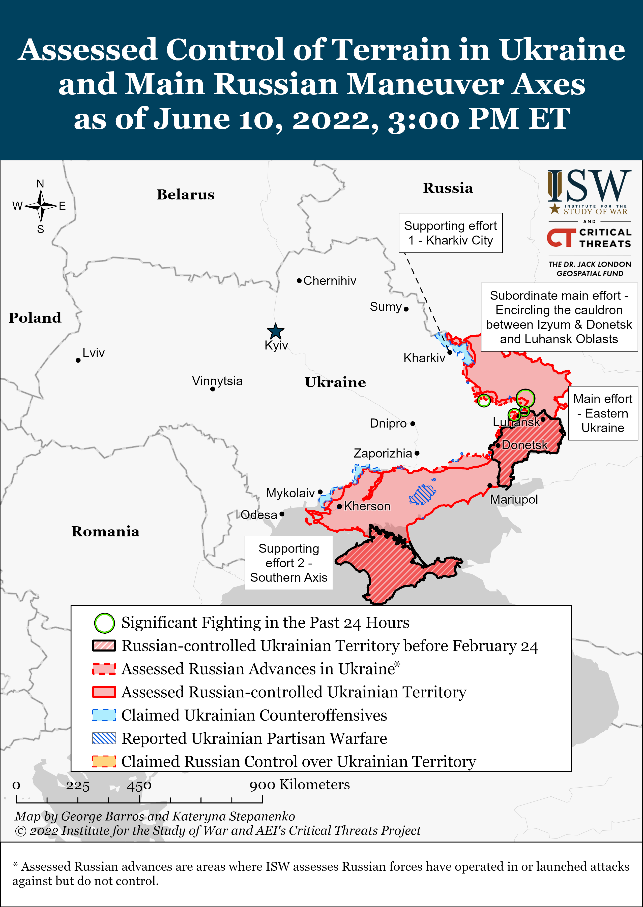
“Ukrainian officials are increasing the urgency of their requests for more-sophisticated Western-provided weapons systems amid reports of growing Russian artillery superiority. Several Western media outlets reported in the last 48 hours that Ukrainian military and government officials are increasingly highlighting the fact that Ukrainian troops are trapped in an “artillery war” on critical frontlines and are at a distinct disadvantage in terms of artillery systems. Deputy Head of the Ukrainian Main Intelligence Directorate (GUR) Vadym Skibitsky stated that Russian troops possess 10 to 15 artillery pieces to every one Ukrainian artillery piece and that Ukrainian forces have almost completely exhausted their artillery ammunition. Considering the current prevalence of protracted positional battles, especially in the Sievierodonetsk-Lysychansk area, Ukrainian forces urgently need fresh supplies of artillery systems. As Ukrainian forces use the last of their stocks of Soviet-era weapon systems and munitions, they will require consistent Western support to transition to new supply chains of ammunition and key artillery systems. Effective artillery will be increasingly decisive in the largely static fighting in eastern Ukraine.
Russian military authorities continue to struggle with force generation and are facing the consequences of aggressive forced mobilization efforts. Ukraine’s Security Service (SBU) claimed they captured a new group of Russian prisoners of war who reportedly were recruited through a private military company and told they were going to be providing security services but were instead sent to the frontline in Luhansk. The Ukrainian General Staff similarly reported that units comprised of forcibly mobilized personnel are refusing to participate in combat in the Donbas due to high losses. The Ukrainian Main Intelligence Directorate (GUR) cited intercepted phone calls and claimed that Russian soldiers are refusing to fight and are being threatened with prosecution—despite their lack of equipment and weapons within their units. Such reports are consistent with previous reports that Russian forced mobilization efforts are self-destructive and may result in mounting discontent and declining morale and discipline.
Key Takeaways
- Ukrainian officials are increasing the urgency of their requests for Western weapons systems due to Russia’s artillery superiority.
- Russian forces are continuing ground assaults within Sievierodonetsk but have yet to secure full control of the city as of June 10.
- Russian forces are preparing to renew offensive operations toward Sloviansk and made minor gains to the north of the city.
- Russian forces are continuing efforts to cut the T1302 Bakhmut-Lysychansk highway and conducting assaults on settlements near the highway.
- Russian troops reportedly took control of the Kinburn Spit in the northern Black Sea, which will allow them to exert further control of the Black Sea coast.“
🇷🇺 are now in control of the Kinburn peninsula SW of Kherson pic.twitter.com/jm08bI4cZD
— Ukraine War Map (@War_Mapper) June 11, 2022
2. Consequences and what to do?
The US and its allies have given billions of dollars in weaponry to Ukraine. Europe has taken in millions of people displaced by the war. And there has been unprecedent unity in post-World War II Europe in imposing sanctions on President Vladimir Putin and his country.
But as the shock of the Feb. 24 invasion subsides, analysts say the Kremlin could exploit a dragged-out, entrenched conflict and possible waning interest among Western powers that might lead to pressuring Ukraine into a settlement.
Ukrainian President Volodymyr Zelenskyy already has chafed at Western suggestions he should accept some sort of compromise. Ukraine, he said, would decide its own terms for peace. The fatigue is growing, people want some kind of outcome (that is beneficial) for themselves, and we want (another) outcome for ourselves, he said.
An Italian peace proposal was dismissed, and French President Emmanuel Macron was met with an angry backlash after he was quoted as saying that although Putin’s invasion was a “historic error,” world powers shouldn’t humiliate Russia, so when the fighting stops, we can build a way out together via diplomatic paths. Ukrainian Foreign Minister Dmytro Kuleba said such talk can only humiliate France and every other country that would call for it.
Even a remark by former US Secretary of State Henry Kissinger that Ukraine should consider territorial concessions drew a retort from Zelenskyy that it was tantamount to European powers in 1938 letting Nazi Germany claim parts of Czechoslovakia to curb Adolf Hitler’s aggression. […]
Every month of the war is costing Ukraine $5 billion, said Volodymyr Fesenko, political analyst with the Penta Center think tank, and that makes Kyiv dependent on the consolidated position of the Western countries. Ukraine will need even more advanced weaponry to secure victory, along with Western determination to keep up the economic pain on Russia to weaken Moscow.
It is obvious that Russia is determined to wear down the West and is now building its strategy on the assumption that Western countries will get tired and gradually begin to change their militant rhetoric to a more accommodating one, Fesenko said in an interview with The Associated Press. […]
While he doesn’t see a significant erosion in the emphatic support for Ukraine,” Gould-Davies [, senior fellow for Russia and Eurasia at the International Institute for Strategic Studies,] said there are hints of different tensions over what the West’s goals should be. Those have not yet been clearly defined.
Europe’s domestic concerns are nudging their way into the discourse, especially as energy prices and raw materials shortages start to take an economic toll on ordinary people who are facing higher electricity bills, fuel costs and grocery prices. While European leaders hailed the decision to block 90% of Russian oil exports by the end of the year as a complete success, it took four weeks of negotiations and included a concession allowing Hungary, widely seen as the Kremlin’s closest EU ally, to continue imports. Weeks more of political fine-tuning are required.
“It shows that unity in Europe is declining a bit on the Russian invasion,’’ said Matteo Villa, an analyst with the ISPI think tank in Milan. There is this kind of fatigue setting in among member states on finding new ways to sanction Russia, and clearly within the European Union, there are some countries that are less and less willing to go on with sanctions.
Wary of the economic impact of further energy sanctions, the European Commission has signaled it won’t rush to propose fresh restrictive measures targeting Russian gas. EU lawmakers are also appealing for financial aid for citizens hit by heating and fuel price hikes to ensure that public support for Ukraine doesn’t wane.
Italy’s right-wing leader Matteo Salvini, who has been seen as close to Moscow, told foreign journalists this week that Italians are ready to make sacrifices, and that his League supports the sanctions against Russia. But he indicated that backing is not unlimited, amid signs the trade balance under sanctions has shifted in Moscow’s favor, hurting small business owners in northern Italy who are part of his base. Italians are very available to make personal economic sacrifices to support Ukraine’s defense and arrive at a cease-fire, Salvini said.
What I would not like is to find us back here in September, after three months with the conflict still ongoing. If that is the case, it will be a disaster for Italy. Beyond the deaths, and saving lives, which is the priority, economically, for Italy, if the war goes on, it will be a disaster, he said.”




